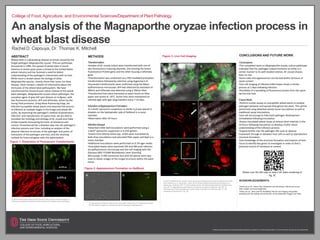
APSPosterWheatBlast
- 1. An analysis of the Magnaporthe oryzae infection process in wheat blast disease Rachel D. Capouya, Dr. Thomas K. Mitchell ABSTRACT Wheat blast is a devastating disease of wheat caused by the fungal pathogen Magnaporthe oryzae, Triticum pathotype. Discovered in 1985, the spread of wheat blast in South America in recent years poses a threat to the United States wheat industry and has fostered a need for better understanding of the pathogen’s interactions with its host. While much is known about the biology of other Magnaporthe species, namely those that cause rice blast disease, there remains a dearth of information about the intricacies of the wheat blast pathosystem. We have transformed the closest known native relative of the wheat blast pathogen, Magnaporthe oryzae Lolium pathotype, the causative agent of grey left spot disease on turfgrass, with two fluorescent proteins, GFP and tdTomato, driven by the strong ToxA promoter. Using these fluorescing fungi, we infected susceptible wheat plants and observed the process of infection at multiple stages in the fungal and wheat life cycles. By examining the pathogen’s method of penetration, infection, and reproduction of a grass host, we are able to elucidate the histology and etiology of M. oryzae and make strides towards discovering the basis of resistance and control. Presented will be a detailed view into the pathogen’s infection process over time, including an analysis of the physical infection structures of the pathogen and points of interaction of the pathogen and host, and the resulting outlook for future progress with this pathosystem. A) GFP-transformed hyphae and B) spores of M. oryzae Lolium pathotype. C) tdTomato-transformed hyphae and D) spores of M. oryzae Lolium pathotype Figure 3: Live Cell ImagingMETHODS Transformation •Isolates of M. oryzae Lolium were transformed with one of two fluorescence-inducing plasmids, one housing the Green Fluorescence Protein gene and the other housing a tdTomato gene. •Transformation was conducted via a PEG-mediated protoplast transformation followed by selection using Hygromycin B. •Successful transformants were confirmed using the Nikon epifluoresence microscope. GFP was detected by excitation at 400nm and tdTomato was detected using a 700nm filter. •Transformed lines were harvested as spore stocks on filter paper and stored at -20°C. Active lines were maintained on oatmeal agar with agar plug transfers every 7-14 days. InductionofAppressoriumFormation •A 1.0x102 spores/mL suspension in sterile H2O was placed in droplets on the hydrophobic side of GelBond in a moist chamber. •Observation after 24 hours InfectionAssays •Detached millet leaf inoculations were performed using a 1.0x105 spores/mL suspension in 0.25% gelatin. •Leaves from Setaria italica spp. viridis were inoculated by both drop inoculations and saturated filter paper and kept in a moist chamber. •Additional inoculations were performed on 0.7% agar media. •Inoculated leaves were examined 24h and 48h post infection via epifluoresence microscopy and live cell imaging with the Olympus MPE FV1000 Multiphoton Laser Scanning Microscope. A 40X immersion lens with 6X optical zoom was used to obtain images of the fungal structures within the plant tissue. CONCLUSIONS AND FUTURE WORK Conclusions •The completed work on Magnaporthe oryzae, Lolium pathotype indicated that this pathogen indeed functions on millet in a similar manner to its well-studied relative, M. oryzae Oryzae, does on rice. •Germ tube and appressorium are formed within 24 hours of spore contact. •Live cell imaging of infected millet leaves shows a similar process at 2 days following infection. •Possibility of a spreading of fluorescent protein from the spore tip into the host. FutureWork •Perform similar assays on susceptible wheat plants to analyze pathogen behavior and spread throughout the plant. This will be performed using detached wheat tissue inoculations as well as traditional spray inoculations. •Live cell microscopy to fully track pathogen development immediately following inoculation. •Assess inoculated wheat tissue at several short intervals in the 24 hours following inoculation to develop a fuller visual understanding of the infection process. •Expand further into the pathogen life cycle to observe movement through or between host cells as well as reproductive structure formation. •Use knowledge of the structure formation and invasion of host tissue to identify key genes to investigate in order to find a potential source of resistance or control. ACKNOWLEDGEMENTS Thank you to Dr. Veena Devi Ganeshan and Dominique Tate for all of your help, insight, and encouragement. Thank you Dr. Sara Cole for facilitating the live cell imaging and greatly assisting with the editing and production of the presented images and video. Figure 2: Appressorium Formation on GelBond Figure 1: Generation of Fluorescent Transformants CFAES provides research and related educational programs to clientele on a nondiscriminatory basis. For more information: http://go.osu.edu/cfaesdiversity. College of Food, Agriculture, and Environmental Sciences/Department of Plant Pathology Please scan the QR code to view a 3D video rendering of Fig. 3C A B C D A) GFP-transformed M. oryzae Lolium spore germinating and forming an appressorium 24h post-infection on S. italcia spp. viridis. B) tdTomato-transformed spore germinating on S. italica spp. viridis two DPI. C) Germinating spores and formed appressorium (white arrow) two DPI. D) Magnaporthe germination and growth throughout millet leaf, two DPI. E) tdTomato spore and appressorium (within white rectangle) on millet two DPI. F) 3D rendering of structures in Fig. 3E. A B C D A) Appressoria formation observed 24 hours after placement on hydrophobic surface. B) Fluorescent image of a transformed spore forming an appressorium. A B E F